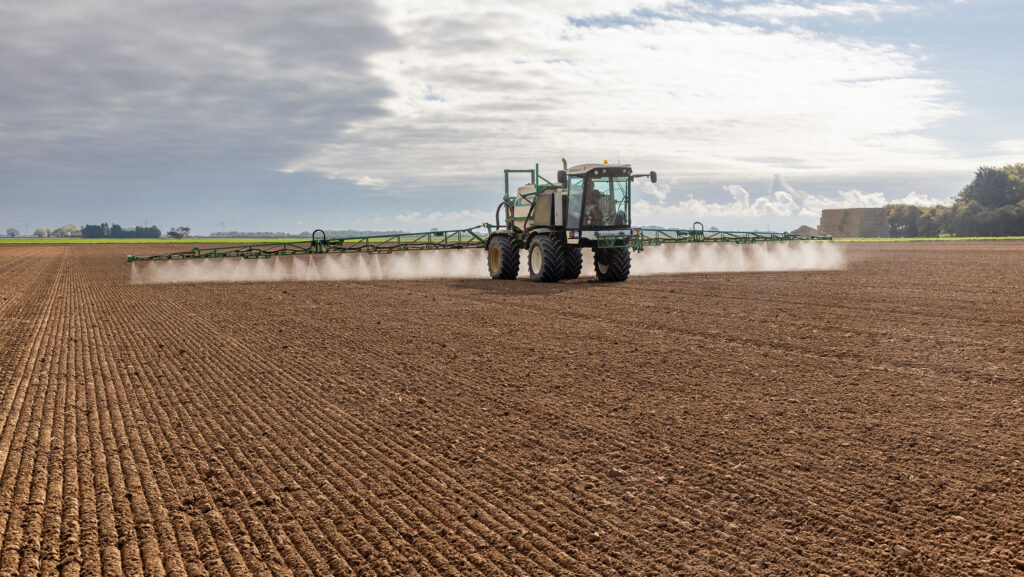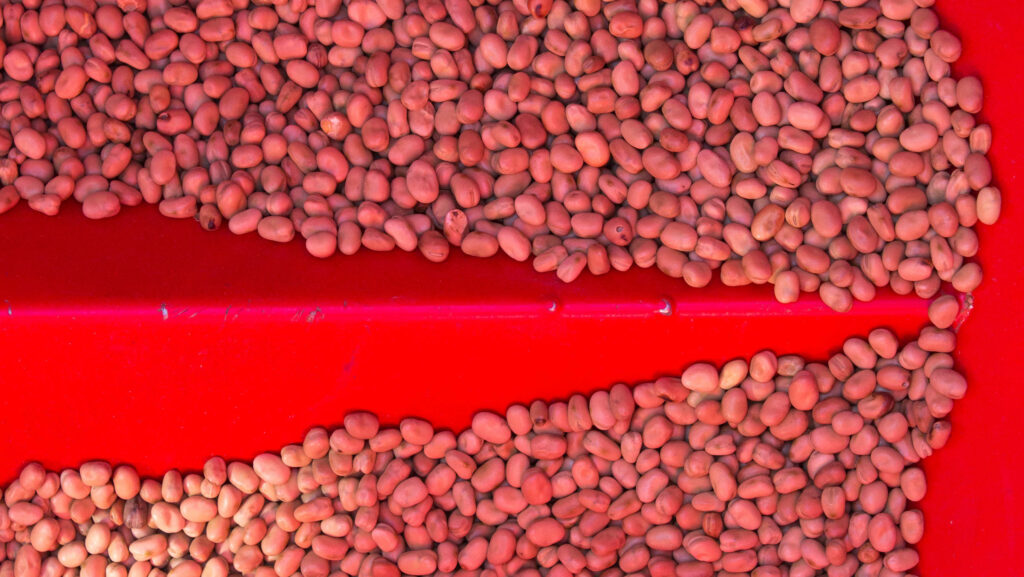Crop Watch: Bean drilling and weed control challenge
 © GNP
© GNP The continued mild autumn is bringing challenges such as managing excessive growth in cover crops and a rising pest and disease threat.
Blackgrass is also starting to emerge in earlier-drilled winter cereals, while in oilseed rape, temperatures remain too high for propyzamide with agronomists considering their options.
See also: How a Somerset farmer grows cereals without plough or herbicides
West
Jamie Armstrong, AICC/Wessex Agronomy (Wilts, Gloucs and Hants)
As we head into November, cereal drilling is finally complete and winter beans are now going in.
Conditions have been unusually kind this autumn; soils have remained workable, seed-beds well structured, and rainfall spaced just enough to help crops on.
After several wet and frustrating seasons, establishment this year is among the best I’ve seen in four years, and there’s a noticeable lift in confidence across the region.
Early-sown winter barley and wheat are looking strong, but are already showing the flip side of a favourable autumn.
Gout fly eggs have been spotted in both crops, particularly in forward fields. After seeing more gouted tillers than usual this spring, it was inevitable we would see more this autumn.
The small white eggs on upper leaves are easy to miss but worth checking for.
Where crops have required an early barley yellow dwarf virus (BYDV) spray, the insecticide may also help to reduce gout fly larvae levels in affected areas.
The AHDB BYDV tool is a useful guide to help time these applications where aphids are found.
Further management of crops with moderate levels of gout fly larvae will shift towards spring actions such as encouraging tillering through rolling and early fertiliser applications.
Blackgrass emergence
Earlier drilling has also encouraged higher blackgrass emergence. Dry conditions meant pre-emergence stacks were less active than last year, but recent rainfall has reactivated them.
Post-emergence residual top-ups may be needed in winter wheats to keep on top of late flushes.
In winter barley, there are very few post-emergence herbicide options, so in some situations the best we can hope for is that competitive crops offer some suppression of grassweeds next spring.
Where blackgrass pressure is low, pre-ems should carry crops through to the spring.
Oilseed rape (OSR) crops are varied; some are well established, others patchy after flea beetle damage earlier in the season.
Phoma leaf spot is now present, particularly in the more advanced crops.
The tricky question, as always at this stage, is whether to stretch fungicide applications until they can be combined with the propyzamide timing or to apply now.
The decision comes down to crop size, varietal resistance and disease risk.
Smaller plants are far more vulnerable to stem canker following early phoma infection, while forward crops with good canopy structure can often wait until late November, when fungicides can be conveniently combined with propyzamide.
Growers and agronomists will need to tread carefully, watching disease development and weather trends before committing either way.
One real positive this autumn has been the performance of the new broad-leaved weed herbicide in OSR, which contains aminopyralid, halauxifen-methyl and picloram.
It has delivered impressive control of otherwise difficult weeds including hedge mustard, bur chervil, groundsel, shepherd’s purse, cranesbill, poppy and more.
From what I’ve seen so far, it’s proving a valuable addition to the OSR toolkit.
Attention is now turning to winter bean drilling, which has either started or is getting under way.
A robust pre-emergence herbicide stack remains the most reliable option for weed control, with few post-emergence choices available.
Aim for a moist seed-bed and even coverage to maximise performance from residuals.
South
Neil Harper, Agrii (Kent)
The open weather has meant it has been non-stop since the start of September. I expect 90% of our winter wheat is in the ground.
The maize harvest has been exceptionally early, which has cleared land for wheat to be sown.
Even our worst blackgrass fields were held off until the middle of October, going in just before a decent rain to help the pre-ems.
Our spades have been kept busy inspecting the condition of our soils to plan remedial work.
You couldn’t have asked for a better autumn to resolve soil structure issues caused by the previous wet years.
Where necessary, we have subsoiled at the correct depth to break up underlying soil compaction.
We have also been faced with the unusual position of managing excessive growth in cover crops. Early-drilled crops have nearly served their purpose.
We must be cautious that some plants are flowering and could start going into seed if left too long; the carbon-to-nitrogen ratio is also shifting, and the stalks are becoming more woody.
Once we have ensured compliance with any schemes the cover crops may be under, we might start terminating them earlier than usual.
Another option is to remove the top layer of the cover crop and allow the other species to do their work lower down in the canopy.
Pre-emergence herbicides
The first single leaf blackgrass plants are visible in the wheat drilled at the end of September. About 50-60% of what is visible is turning a colour, indicating it is taking up the pre-emergence herbicide.
We believe that where pre-ems have been used correctly on fields with high blackgrass pressure, using cinmethylin and aclonifen-type mixes, we have achieved good control, but time will eventually tell.
There are also positive reports of grassweeds clearly taking up Fundatis (bixlozone + beflubutamid) where it has been tried.
If we need to apply an insecticide for gout fly or aphids, we may include some pendimethalin or picolinafen to further enhance persistency into the autumn.
There are also some agronomists locally contemplating an autumn contact graminicide, which is more applicable where weeds have got to two to three leaves and are still actively growing.
Weed control is also a concern in OSR. Most crops received an application of clethodim a few weeks ago, and anything that survived is now growing quite large.
Soil temperatures are way too high for propyzamide to work effectively.
It becomes a balancing act between canopies that are too big for good spray coverage and soil temperatures that are too high.
We are having a similar debate about propyzamide timing in winter beans.
Crops have been drilled two to four weeks earlier than usual, and with such a heavy reliance on propyzamide for pre-emergence grass weed control, it leaves us considering what to do.
North
Conor Campbell, Hutchinsons (Northumberland)
We’ve had an incredibly kind October which has allowed us to get the last of the wheat after potatoes and maize sown in record time and excellent conditions.
The biggest benefit of the mild conditions is that the small, backward OSR crops have had a chance to put on some biomass before winter.
The concern on our minds is keeping pigeons under control, as we lack the biomass to really handle a lot of grazing pressure.
We’ve had a secondary flush of volunteers to tackle and this has been a great opportunity for encouraging growth.
My focus has primarily been on growth promoting products such as phosphites rather than trace element nutrition.
We will be looking to apply our propyzamide products towards the end of the month before ground conditions become too challenging.
There is always a trade-off between waiting for the correct soil conditions for maximum residual activity, targeting the actively growing weeds in good growing conditions and actually get the products on before travelling on the fields becomes impossible.
Mild conditions will increase early disease pressure so think about your fungicide choice.
Prothioconazole is the strongest option, but you may need the addition of tebuconazole or metconazole for canopy manipulation.
Manganese in barley
The uncertainty around the weather meant a lot of later sown crops didn’t get rolled.
This was the correct decision, as often you can do more harm than good, but the trade-off has been early manganese deficiency in barley crops.
Warm soils promoted fast germination, but the small root systems in loose seed-beds, meant they struggled.
We’ve been able to get across them all with some manganese, which is great for setting them up ahead of the spring.
Now is a great chance to tackle any grassweeds before the weather breaks.
We seldom have the opportunity to take out small brome and ryegrass before they get too big so I’m taking advantage this week.
Of course, that negates any treatment in the spring, but I feel I’ve seen a good flush.
I’ve put the new Isoflex (bixlozone) active in some of my more challenging barley situations, so we will see how grassweed control looks in the spring.
East
Dan Ives, Agrovista (Herts, Beds, Cambs and Essex)

© Tim Scrivener
Crops have emerged exceptionally well from the best seed-beds achieved for many years.
Pre-emergence herbicides applied to cereals before rain have worked well. Where moisture was scarce grassweed pressure is higher, which is to be expected.
Winter barley sown in mid-September has received top-up residuals, helping to keep any late-emerging grassweeds at bay.
Depending on need I have included BYDV protection as mild temperatures throughout early October kept aphid numbers higher than normal and T sums were reached.
Broad-leaved weeds
In some situations, I have noticed more broad-leaved weeds breaching the pre-emergence barrier due to dry conditions, so I have topped up with some more diflufenican/pendimethalin as necessary.
However, I tend to avoid this approach on winter barley due to be followed by OSR due to higher risk of residual within the soil hindering that crop.
Later-sown wheats on the other hand have received 30mm of rain in places, maximising pre-emergence performance.
Apart from known hot spots fields look clean. I have trialled some new chemistry in the form of Isoflex in specific places to compare performance against the standards.
In high-pressure situations it seems to be hurting grassweeds nicely. It is vital to experiment with new actives to learn how best to place them within future programmes.
OSR generally has made use of recent showers and responded well. Forward crops have reached maximum canopy for the autumn/winter with low levels of pest damage within the plant.
Later-sown crops will need a bit more encouragement after a prolonged dry period during key growth stages, but tailored nutrition has kept them going.
I tend to opt for either amino acids plus trace elements to aid leaf growth and nutrient uptake or a form of liquid phosphate to aid rooting to help scavenge seed-bed nutrition.
Recent heavier showers have triggered a strong flush of broad-leaved weeds which have been cleaned up.
Tip of the week
Attention is now turning to winter bean drilling. A robust pre-emergence herbicide stack remains the most reliable option for weed control.
Jamie Armstrong

